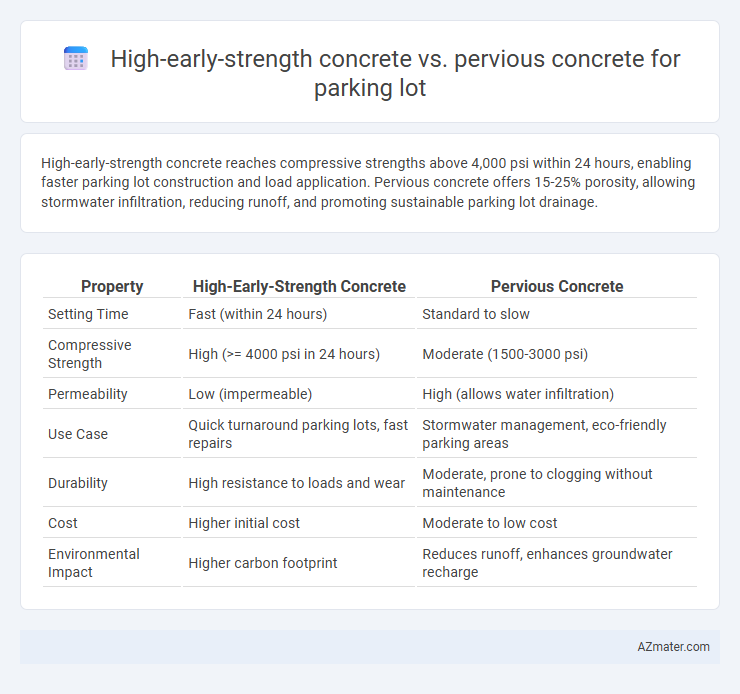High-early-strength concrete reaches compressive strengths above 4,000 psi within 24 hours, enabling faster parking lot construction and load application. Pervious concrete offers 15-25% porosity, allowing stormwater infiltration, reducing runoff, and promoting sustainable parking lot drainage.
Table of Comparison
| Property | High-Early-Strength Concrete | Pervious Concrete |
|---|---|---|
| Setting Time | Fast (within 24 hours) | Standard to slow |
| Compressive Strength | High (>= 4000 psi in 24 hours) | Moderate (1500-3000 psi) |
| Permeability | Low (impermeable) | High (allows water infiltration) |
| Use Case | Quick turnaround parking lots, fast repairs | Stormwater management, eco-friendly parking areas |
| Durability | High resistance to loads and wear | Moderate, prone to clogging without maintenance |
| Cost | Higher initial cost | Moderate to low cost |
| Environmental Impact | Higher carbon footprint | Reduces runoff, enhances groundwater recharge |
Introduction to High-Early-Strength vs Pervious Concrete
High-early-strength concrete achieves rapid strength gain within hours, enabling faster construction turnaround for parking lots, reducing downtime and allowing quick use. Pervious concrete offers superior stormwater management by allowing water infiltration through its porous structure, reducing runoff and improving groundwater recharge. Selecting between high-early-strength and pervious concrete depends on project priorities such as load-bearing requirements and environmental sustainability goals in parking lot design.
Key Characteristics of High-Early-Strength Concrete
High-early-strength concrete achieves compressive strengths of 2,500 psi or more within 24 hours, making it ideal for fast-track parking lot projects requiring rapid load-bearing capacity. Its accelerated hydration process is facilitated by higher cement content and chemical admixtures like calcium chloride, enhancing early strength development. This concrete type offers superior durability and reduced curing time compared to pervious concrete, which prioritizes permeability and stormwater management but generally attains lower early strength.
Key Characteristics of Pervious Concrete
Pervious concrete is highly valued for parking lots due to its porous structure, allowing efficient stormwater drainage and reducing runoff, which helps to mitigate flooding and recharge groundwater. This type of concrete typically features high void content between 15% to 25%, providing excellent permeability while maintaining sufficient strength for vehicle loads. Unlike high-early-strength concrete that prioritizes rapid load-bearing capacity, pervious concrete's key characteristic is its eco-friendly design that balances durability with environmental benefits in parking lot applications.
Strength and Durability Comparison
High-early-strength concrete achieves compressive strengths above 4,000 psi within the first 24 hours, making it ideal for rapid construction and heavy vehicle loads in parking lots. Pervious concrete, while typically reaching lower compressive strengths around 2,500 to 3,500 psi, excels in durability through superior water permeability that reduces hydrostatic pressure and prevents surface deterioration. The strength advantage of high-early-strength concrete supports heavy-duty applications, whereas pervious concrete enhances longevity by minimizing water-related damage and improving stormwater management.
Permeability and Drainage Performance
High-early-strength concrete offers rapid load-bearing capacity but has low permeability, making it less effective in managing surface water runoff in parking lots. Pervious concrete, with its interconnected pore structure, significantly enhances permeability and drainage performance, allowing stormwater to infiltrate and reduce surface pooling. Selecting pervious concrete improves water management and mitigates hydroplaning risks, critical for parking lot safety and environmental compliance.
Environmental Impact and Sustainability
High-early-strength concrete offers rapid load-bearing capacity, reducing construction time but often involves higher cement content, leading to increased carbon emissions and environmental impact. Pervious concrete enhances stormwater management by allowing water infiltration, promoting groundwater recharge and reducing runoff pollution, thus supporting sustainable urban drainage systems. Selecting pervious concrete for parking lots significantly improves environmental sustainability by minimizing heat island effect and enhancing water quality, whereas high-early-strength concrete prioritizes structural efficiency over ecological benefits.
Installation Processes and Construction Time
High-early-strength concrete accelerates parking lot installation by reaching desired strength within 24 hours, facilitating rapid construction and minimizing downtime. In contrast, pervious concrete requires extended curing periods to maintain permeability and structural integrity, leading to longer installation times. Selecting high-early-strength concrete maximizes efficiency, while pervious concrete prioritizes environmental benefits at the cost of increased construction duration.
Maintenance Requirements and Longevity
High-early-strength concrete enables rapid project completion with its quick curing time but may require periodic sealing to prevent surface wear and maintain longevity, typically offering a lifespan of 20 to 30 years under standard parking lot conditions. Pervious concrete significantly reduces surface runoff and enhances stormwater management but demands regular vacuuming or pressure washing to prevent clogging and preserve permeability, which can affect its durability and lifespan, generally ranging from 15 to 25 years. Maintenance frequency for pervious concrete is higher due to its porous structure, while high-early-strength concrete demands less frequent upkeep but may be more vulnerable to freeze-thaw damage if improperly sealed.
Cost Analysis and Budget Considerations
High-early-strength concrete offers faster curing times that reduce labor costs and enable quicker project turnover, but it entails higher material expenses compared to traditional mixes. Pervious concrete provides benefits such as improved stormwater management and compliance with sustainable design regulations, potentially lowering long-term environmental fees and drainage infrastructure costs. Budget considerations must weigh upfront costs versus lifecycle savings, with high-early-strength concrete favored for rapid construction and pervious concrete preferred for environmentally driven projects with stormwater management priorities.
Choosing the Best Concrete Type for Parking Lots
High-early-strength concrete offers rapid strength gain, allowing parking lots to reopen quickly and reducing downtime, which is ideal for high-traffic commercial areas. Pervious concrete enhances stormwater management by allowing water to infiltrate through the surface, reducing runoff and improving environmental compliance for parking lot pavements. Selecting between these concrete types depends on balancing immediate operational needs with long-term sustainability goals, considering factors such as load-bearing requirements and local climate conditions.

Infographic: High-early-strength concrete vs Pervious concrete for Parking lot
 azmater.com
azmater.com